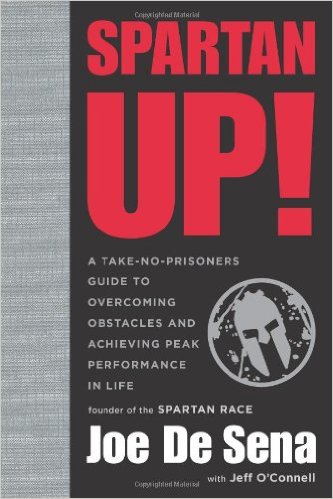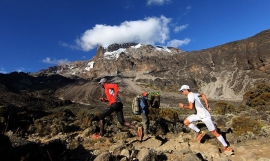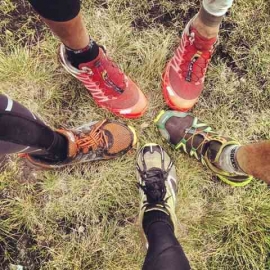Spartan Up!: A Take-No-Prisoners Guide to Overcoming Obstacles and Achieving Peak Performance in Life
Twenty-six point two miles isn’t enough anymore. Obstacle course racing, which combines the endurance challenges of a marathon with the mind-bending rigors of overcoming obstacles along the way, is taking the world by storm. At the center of this phenomenon is Joe De Sena, the driving force behind the enormously popular Spartan Race. De Sena offers a simple philosophy: commit to a goal, put in the work, and get it done. From that philosophy, as played out first in his own life and now for millions across trails, through mud, and up mountainsides, Spartan Race was born.
Now in Spartan Up! De Sena gives you a life strategy guide that takes you out of your comfort zone and into a combat zone. As he breaks down obstacles from his many races, detailing how each parallels real life experiences, you will learn how to:
• conquer your greatest obstacle—your will
• embrace your greatest friend—discipline
• make limitations vanish and establish a new normal
• achieve the ultimate: obstacle immunity
Other events breed sheep; Spartan Race breeds wolves. Filled with unforgettable stories of Spartan racers as well as hard-won truths learned along the course, Spartan Up! will help anyone reach their full potential—in life, business, relationships, indeed anything one sets out to do. It is the blueprint that takes you right past Go to your finish line.
Spartan Up!: A Take-No-Prisoners Guide to Overcoming Obstacles and Achieving Peak Performance in Life Review
"Joe DeSena is the real deal. His stories are believable, because his achievements and accomplishments are genuine. In Spartan Up! Joe delivers his message with the insight and candor that only an individual who has lived through such experiences can. A must read for anyone looking to take his performance to the next level, be it in athletics or in life." – Dean Karnazes, ultramarathoner and New York Times bestselling author of Ultra Marathon Man
"Have you ever wanted to be more, been stuck in a funk or simply wanted make life poignant? Look no further because Spartan Up! is your catalyst. Loaded with real life inspiration and lessons, Joe De Sena uses his supercharged success in life, business and sports to deliver the nuggets. This is an easy and juicy read; succinct, powerful and relevant." – Ian Adamson, world champion adventure racer and author of The Runner’s World Guide to Adventure Racing"If there's anyone out there who has taken extreme to a new level, its Joe De Sena – in adventure racing, in business, and ultimately in the business of adventure! Spartan Up! is must-read." –Robyn Benincasa, world champion adventure racer and New York Times bestselling author of How Winning Works"Joe De Sena is the real deal in endurance sports and Obstacle Racing. Spartan Up! will guide you to train your body and mind for the arduous Spartan Race - while also giving you very practical insights to perform at your peak in all areas of your life." – Mark Divine, founder, SEALFIT and author of The Way of the SEAL and Unbeatable Mind"Two words describe Joe De Sena and Spartan Up!.... Game Changer! Read this book and you will dramatically transform the way you think, lead, work, and live. This is the ultimate resource for personal and professional transformation. Spartan Up gives you an actionable blueprint to go beyond just adapting and surviving to excelling and thriving. If success is your goal, whether you're a Navy SEAL, Wall Street Exec, homemaker, teacher or doctor, you need this book." -- John Brubaker, world renowned performance consultant and author of The Coach Approach: Success Strategies From The Locker Room To The Board Room
About the Author
Thirty Below and Nowhere to Go
The Raid International Ukatak was an endurance race held in Quebec in the dead of winter, the absolute coldest time of the year. Temperatures are known to drop as low as thirty degrees below zero. Friends had talked me into doing this race—why else would I be standing at the starting line with three team members on a tiny island on the Saint Lawrence River in Quebec. To reach the finish line we would have to cover 350 desolate, barren, frozen miles. We would travel by iceboat, snowshoes, skis, and, believe it or not, mountain bike through nearly frozen rivers and snowy, rocky terrain that would discourage any sane person from entering. I knew this race was going to take six days if things went according to plan. I also knew that nothing ever went according to plan.
Despite the freezing temperatures, it was sunny and the sky was blue. The bright-colored gear of the competitors popped against the white snow. We began by iceboating along the Saint Lawrence River, which was like navigating a canoe seating four, with me in the back, through the Arctic Ocean. Floating chunks of white ice would knock into our boat and send us overboard, splashing into ice-cold water like seals going for a dip. But in a race like this, there was nowhere to go to change into dry clothes, nowhere to warm up. Once your clothes were soaked in ice water, your bones were chilled and would stay that way until the temperature rose. You were as cold as if you were naked. People die of hypothermia in these conditions. This was at the beginning of the race.
After we reached our destination along the Saint Lawrence, we hiked for two days straight through knee-deep snow in ten-to-thirty-degrees-below temperature. To muster the energy to keep going, I’d stop with my team when necessary to chug olive oil from a bottle. It seemed like logical choice to me: I could carry it, and it was loaded with lots of calories. In retrospect, it worked. But it wasn’t without side effects.
Anyone who has done an ultraendurance event has at least some sense of the mentality it takes to distance oneself from one’s body and keep pushing forward, impervious to every human impulse and basic common sense telling you to stop. Essentially your rational mind stops functioning, you lose the ability to reason, and you start functioning only in a primal way.
On the third night we trudged on snowshoes toward the top of a ridge, and images of my family members’ and friends’ faces appeared before me. Everywhere I looked, I saw their heads staring at me along the trail. For hours, I thought, What are they doing here? I also saw a McDonald’s off the side of the trail . . . but it couldn’t be, because I was in the middle of nowhere. Not only did the golden arches loom but the distinctive, pungent odor of a Quarter Pounder with Cheese and french fries blasted my nostrils. When you’re starting to lose your mind like I was, it’s amazing what grabs hold of it—in my case, apparently, trans fats and ketchup. I was officially losing it.
We were to rappel fifteen hundred feet down a cliff, at which point we would continue onward toward the finish line. We were in second place at this point, right behind the front-runners, still hopeful we could win—which was a shock for me, knowing I wasn’t an athlete and had no business being here. The combined athletic experience of my teammates was measured in decades. I came from Wall Street, and before that, cleaned swimming pools. I would be relying on my mental toughness to make up for not being as physically fit as my teammates. This was the equivalent of the Olympics of adventure racing, and here I was, a pool cleaner, trying to
keep up.
As we neared the ridge, I could tell something was wrong. The team in front of us had experienced a mishap: The ropes linking the ridge to the ground below had come loose and were no longer connected safely. To rappel down at that point might have ended with a red splatter in the pristine snow, a risk even we weren’t willing to take.
There we were, standing at the cliff, with nowhere to go while the other team tried to figure out how to reconnect these ropes. We could hear commotion and saw headlamps lit below the cliff edge. When you’re hallucinating human heads and golden arches, it’s probably not the right time to be rappelling fifteen hundred feet, especially when the ropes are also having issues. With nightfall approaching, we saw no other way down, and we couldn’t turn back now. The nearest camp, a few huddled tents, was the one we’d left at the beginning of the day. So, with the freezing wind swirling around us, we looked at each other without speaking, all thinking exactly the same thing: Fuuuuuuuuck. We would be spending the night in the snow without shelter, since bringing a fully functioning tent would have weighed too much to carry for six days. We hadn’t planned on sleeping till we collapsed. That was our “plan.” We had ignored the safety requirement of carrying a tent. Since we had no intention of using it, this would save weight.
This night was going to suck, but I didn’t know how much. I burrowed into the freezing white because it was the only shelter from the Arctic blast of wind, but the conditions and the intensity of energy expenditure they provoked made it impossible to sleep. Those conditions hijack the rational part of your brain, the part of you that you think of as “you.” All I could do was shake in misery until sunup, whenever that would come. I was in that state people must reach when they’re lost in the wilderness, where they simply don’t give a fuck anymore if they live or die, because if they die, at least the misery will come to end.
The next day, when the brief window of light appeared, we learned that the rope couldn’t be fixed. The first-place team had made their way down, and we could either wait and hope they solved the problem or head out and try to catch them by foot back down the mountain. After discussing our predicament, we decided that we would try to ice-climb down this surface that you normally would only rappel. Every potential opening or possible path to slide, jump, or roll down that we evaluated had some fatal flaw, literally. This was like trying to hike down a triple black diamond ski slope that could never be skied. It was covered in waist-deep snow and littered with deathtraps in every direction.
Finally, we spotted one sliver of snow that seemed to work its way through the craggy rockface. Without much in the way of options, we began to climb down, searching for hand- and footholds. The ice was covered with snow and less stable than rock formations, but much safer considering our limited gear. This passage was so tight that we couldn’t go far to the right or left or we might plunge to our death. We’d climb over fallen trees, and then suddenly we’d hit a ten-foot drop that would send us sliding precariously close to the rockface. This six-hour descent would be perilous at best. And I was just an average guy in an extraordinary situation. I had been training only six months for this event. I lived in New York City and had a desk job.
Finally, we made it to the bottom. I turned around, looked up, and saw the rock rising fifteen hundred feet up, except for this tiny little ribbon of snow area that we had come down. Looking up at it, we thought, Holy shit, how fucking stupid were we? A few feet in the wrong direction, and we would have been dead. Certainly an accomplishment, but not one I would ever repeat.
Later in the race, we encountered more difficulty. We were cross-country skiing for sixty miles, but because we had the wrong skis and no wax, we found ourselves in what seemed like a silly situation. We were on a cross-country ski trail where two small tracks exist for your skis. This tracked snow trail would go on for sixty-plus miles out in the middle of nowhere. The trail was very hilly with steep climbs and descents.
Pretty quickly, we realized we were stuck. Our skis could not get us up the climbs. We were skiing in place and not going anywhere. We looked at each other, frustrated, and popped off our skis—only to fall into waist-deep snow that was like quicksand. Although it sounds silly, we were literally stuck in our tracks. We couldn’t go forward or backward, and when we had our skis off we couldn’t get them back on.
Adrian, one of the guys on our team, had climbed Everest and was our resident expert. His presence had made me feel more comfortable about being out here in the first place; he was obviously a pro at handling difficult challenges. I looked at him like a nervous patient looking for reassurance from a doctor. At one point, he turned to me and said: “We got a serious situation here. This could be dire.” That scared the shit out of me.
Yet somehow, we slogged through it, and eventually we caught a break when the temperature dropped. Apparently, for those who understand backcountry skiing—and we didn’t—different waxes “stick” to snow at different temperatures. Like something out of a movie, and without notice, we were magically on our way again.
But that night I spent on the mountain hallucinating was the worst stretch of my life. I don’t say that lightly, either; I’ve had some pretty close calls over the last forty years. Usually, when life presents such situations, there’s a clear end in sight. Okay, maybe it’s freezing cold out—but in two hours, I’ll be back to the car, and I can crank up the heat. Sure, this procedure hurts like hell—but I can signal the doctor or dentist for more numbing agents if necessary. Yeah, I just stubbed my toe—but this too shall quickly pass.
That night, there was no end in sight. The sun would come up, but it would still be well below zero even in daylight. Under the best-case scenario, we were still totally fucked. No one was coming to rescue us. We still had to find our way down. And we did. Do that enough times, break through obstacles safely, and eventually you get this sense of security, whether false or not, that you’re going to be all right if you just push through it. Let’s face it, no matter what challenges confront me during my day, they probably won’t be as severe as the circumstances on that ridge.
An inverse correlation links how miserable you feel in the race, and how great you feel after it, so you can bet I felt like a million bucks afterward. When you break through the other side of hell and finish an event that did not seem possible, that stopped you in your tracks over and over, something happens. You feel accomplished, incredibly proud of yourself and, in some ways, a different person.
Since the Ukatek, I have been lucky and stupid enough to compete in some of the most grueling endurance events in existence. When I tell people what I’m about to do, most of them look at me in a way that tells me they think I’m really stupid or suicidal. But you know what? There’s a better way of looking at this. Challenging yourself to accomplish more than you know you can is never stupid—it helps show you what you are capable of. It creates a new frame of reference, one you can draw upon in the face of other things that are perceived as being tough in your life. It shows you possibilities you didn’t know existed.
That’s why I started the Spartan Race, and that’s why I wrote this book.
Spartan Up!: A Take-No-Prisoners Guide to Overcoming Obstacles and Achieving Peak Performance in Life Biography
Spartan Up!: A Take-No-Prisoners Guide to Overcoming Obstacles and Achieving Peak Performance in Life Customer Reviews
This book wasn't quite what I expected, but I learned a lot from it. Life can be like that - and I think it is fair to say that this is one theme in the book. Funny how that happened.
Oddly enough, as I write this, my wife is watching the New York Housewives on TV, and two of them are running a Spartan Race. Quite a coincidence, given that these races are the backdrop for the book. One of the women did not enjoy the experience. Her husband tried to explain the point of what they did, but she didn't get it.
I had never heard of Spartan races before reading this book. Think a race through an obstacle course from hell, and you'll get the picture. Big, unexpected challenges.
The point of these races seems to be to push the runners hard and teach them something about life in the process - in a word, how to overcome. Or maybe, it's better to say that they teach people something about how life really is/should be, as opposed to the "fake" one that today's society has created/imposed upon us (or most of us). Doing the seeming impossible is possible if one applies the Spartan "way".
The book is critical of how children are coddled today, even to the point of being given prizes for showing up to a competition, whether they win of lose. I'm in my 50's, and this is certainly not how it was when I was a kid - what happened? Is there any wonder why kids grow up so "entitled" now? A rude awakening is the result. Bad all around.
There is also criticism of many aspects of modern life. Too much electronics, too much bad food, not enough exercise, etc. No argument here. I made some changes in my life regarding all this recently and am happy with the results.
更多跑步书籍见://www.nduoke.com//www.nduoke.com/running-books
跑步书籍下载见://www.nduoke.com//www.nduoke.com/shujixiazai
跑步书籍百科见://www.nduoke.com//www.nduoke.com/shujibaike
跑步书籍下载地址合集 ://www.nduoke.com//www.nduoke.com/shujixiazai/download
跑步书籍汇集大全附下载 ://www.nduoke.com//www.nduoke.com/running-books/daquan




